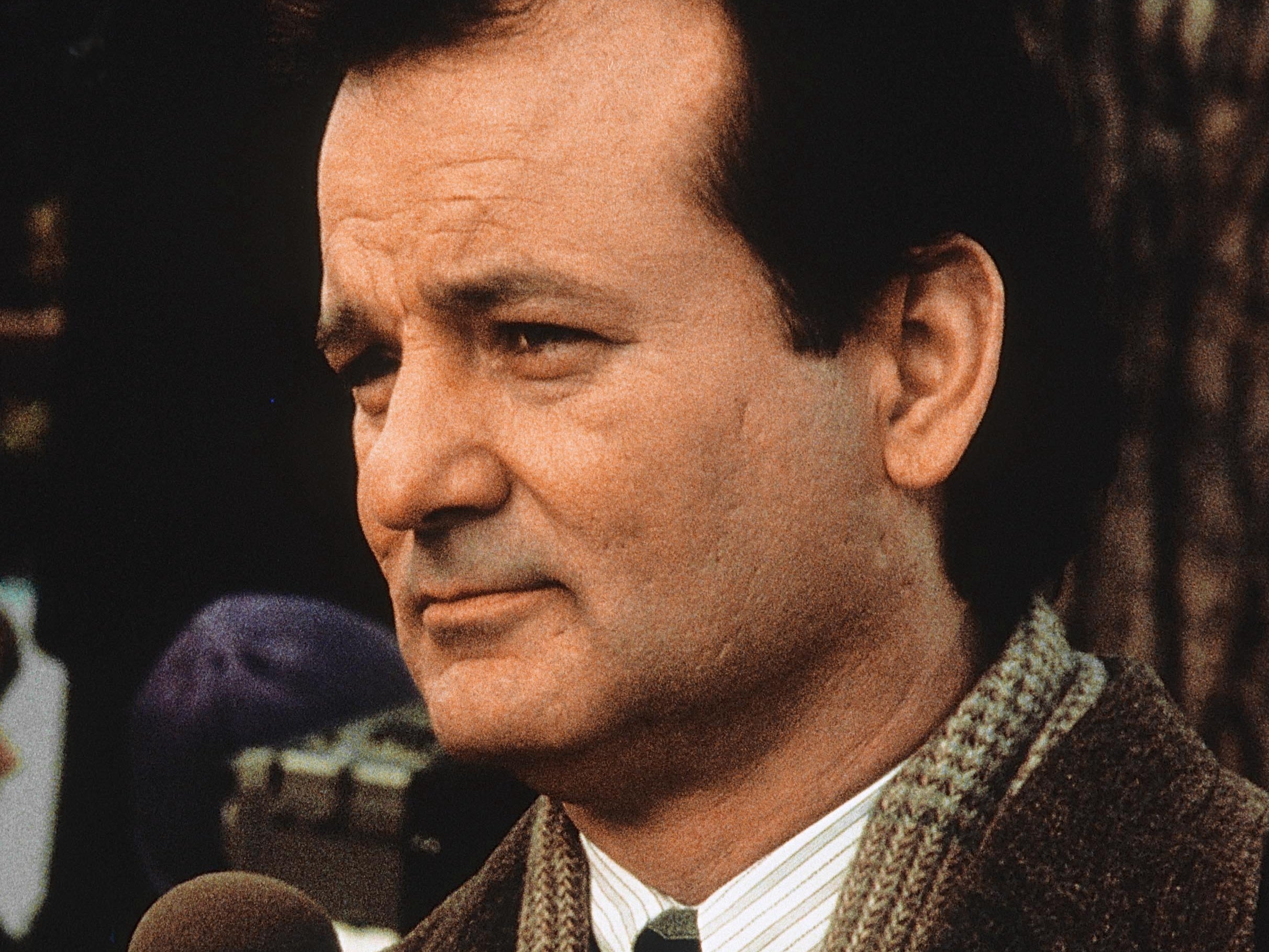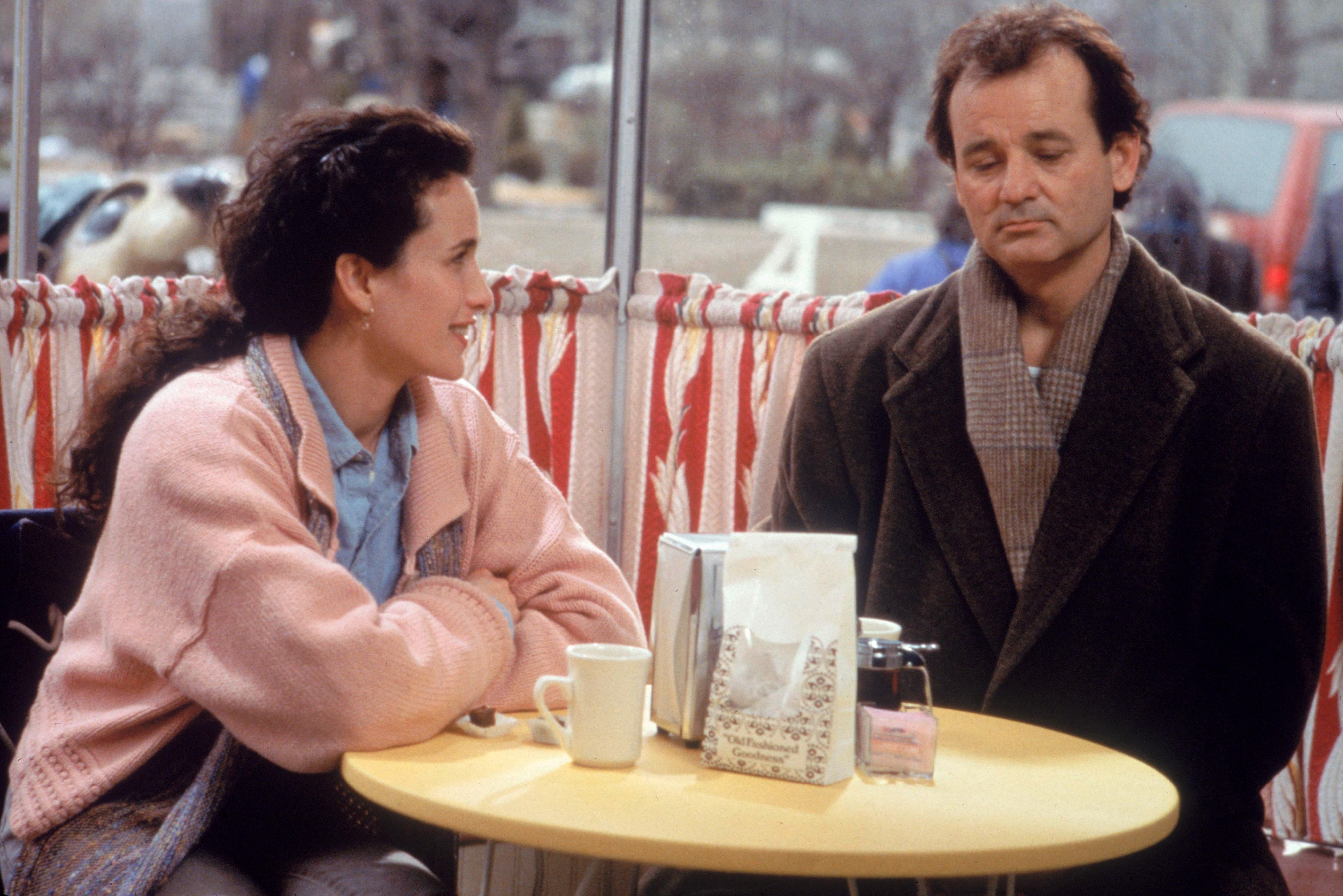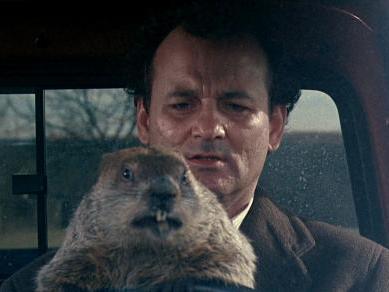German monks, animal bites and Bill Murray’s feud: How Groundhog Day became the film we can’t stop re-living
The 1993 time-loop movie is being celebrated this week at the Berlin Film Festival to mark its 30th anniversary. Geoffrey Macnab looks back on the film that appealed in equal measure to kids, Nietzschean philosophers, misanthropes and old-fashioned romcom fans

It’s 6am. The radio alarm goes off and yet again the beleaguered, middle-aged weatherman, stranded in a time loop, is woken up by the drone of the Sonny and Cher song, “I Got You Babe”. Its repetitive harmonies are beginning to drive him mad, just as they did the day before, and the day before that. He thinks he is in hell and you can hardly blame him. The water in the shower is still freezing cold. The moment he ventures out onto the sidewalk, he’s accosted by the same creepy insurance salesman whose manic grin seems even more grotesque than it was the day before. And he steps into the same puddle, too.
This is the nightmarish world conjured up in Harold Ramis’s Groundhog Day (1993). In his most celebrated performance, Bill Murray plays the long-suffering meteorologist with a beguiling mix of sourness, petulance and wry bemusement. Audiences delight in his tribulations. He is like a character in an old slapstick silent movie who keeps on slipping on the same banana skin.
There aren’t many other mainstream Hollywood movies that appeal in equal measure to kids, Buddhists, Nietzschean philosophers interested in the idea of eternal recurrence, misanthropes, horror movie aficionados and fans of old-fashioned romantic comedies.
Thirty years after its release, Ramis’s much-cherished movie is back on the big screen this week at the Berlin Film Festival. It has been chosen by German director Nora Fingscheidt (best known for her Sandra Bullock movie The Unforgivable) as part of a “Coming of Age at the Movies” retrospective. She first saw it as an eight-year-old. “After watching the film, I was laying in bed, thinking, what if today starts again tomorrow and what if I can do whatever I want because tomorrow nobody will know about it any more?” Fingscheidt says, remembering why the film had such an impact on her. “It was a movie that, in spite of being very funny and entertaining, actually started to raise philosophical questions.”
One of the issues with Groundhog Day, ironically, is that it has become just too familiar. Over the decades, its title has seeped into everyday parlance. Any commuter or school kid caught up in an undeviating routine is likely to invoke it.
An Australia-based academic, Adam Daniel, recently wrote an essay for the highbrow news analysis and comment site The Conversation about his experiences watching the film every day for a year during the Covid lockdown. In the movie, Murray’s curmudgeonly weather forecaster Phil Connors was desperately trying to escape the endlessly recurring time loop in which he had become trapped. In an act of extreme cinematic masochism, Daniel was doing the reverse by wilfully condemning himself to repeat the same viewing experience ad infinitum.
A visit to the cinema is supposed to be an escape from the drab routine of everyday life, but Groundhog Day buries us up to our noses in routine. Everyone knows the premise. Phil is sent, on a cold February day, to Punxsutawney, Pennsylvania, to report on the Groundhog Day festival held there every year. If the groundhog (a hairy little mammal that looks like a large squirrel) sees its own shadow, winter will last another six weeks. If it doesn’t, an early spring will soon follow.
“Chance of departure today... 100 per cent,” Phil tells his kindly landlady at the start of the movie as he leaves the quaint B&B where he has stayed the night. He can’t wait to get out of town. The Punxsutawney job sums up everything that has gone wrong with his life. He should be the face of a major network. Instead, he is on the treadmill, working for Channel 9, a small-time Pittsburgh TV outfit, reliving the same experiences over and over again – and that is even before he gets caught in the time loop.
Then comes a giant blizzard, and he ends up stranded in Punxsutawney, locked into the same day, seemingly forever.

Three decades on, one element of the film that leaps out is Phil’s sexist behaviour toward his new producer Rita (Andie MacDowell), with whom he soon falls in love. He wouldn’t get away today with asking her to help him with his pelvic thrusts or telling her that, no, he can’t come to dinner because he intends to spend his evening reading Hustler magazine.
There is a lot of meanness and cynicism within Groundhog Day. The problems behind the scenes during its making have been exhaustively chronicled. Ramis and Murray were old friends and collaborators who had worked on several previous pictures but their experiences in Punxsutawney created a rift between them, which wasn’t bridged until just before Ramis’s death in 2014. The director was planning an upbeat, optimistic comedy. His mercurial, bad-tempered star was looking to do something far darker.
It is somehow in keeping with the sour mood on set that Murray was reportedly bitten by the groundhog at one stage, and had to have an anti-rabies shot. “You root for him even though he is behaving horribly,” Fingscheidt notes of the film’s cheerily obnoxious anti-hero. “Bill wanted it to be more philosophical, and Harold kept reminding him it was a comedy,” the film’s writer Danny Rubin later recalled.
The tension between the two, though, was what gave the film its edge. The storytelling was both jolly and very macabre, wholesome and subversive. This was a high-spirited comedy but one full of jokes about suicide and existential despair. It had all the hallmarks of a horror movie or of one of those twisted psychological thrillers that Hitchcock specialised in late in his career.
Ramis even makes some attempt at social comment. At one stage, Phil is shown in a bar at the bowling alley, drinking with some deadbeats. “What would you do if you were stuck in one place and every day was exactly the same and nothing that you did mattered?” he asks them. “That about sums it up for me,” one of the drinking companions replies in sullen tones. At points like these, the film turns into a critique of the mind-numbing conformity of the American way of life.
Phil soon rebels. If he is condemned to live the same day again and again, he quickly works out that he can do anything he wants and it won’t make any difference. He can be reckless sexually and eat as much junk food as he can stomach. He can also devise ever more elaborate ways of killing himself. The result, though, is always the same. Over the course of the movie, Murray’s character is stabbed, shot, frozen, hanged, electrocuted and burned – and he always bounces up yet again at 6am to the sound of Sonny and Cher.
It’s not surprising that several of the time loop films that have been made since Groundhog Day have been very morbid. Producer Jason Blum used the concept for the 2017 shocker, Happy Death Day, in which a female college student is stabbed to death again and again, on a daily basis – and ends up investigating her own murder. That film was accused of ripping off Ramis but really it was just tapping further into the darkness that lurked in the original.

Other variations on Groundhog Day have picked up on its philosophical undertow – the idea that if you keep on living the same day again and again, you can teach yourself to live it better. The worst day of your life can then turn into the best.
Phil yo-yos between despair and feelings of invincibility. In his more belligerent moments, he thinks he’s a god. You can see traces of the sardonic weather forecaster in present-day movie superheroes. They too have the gift, or curse, of immortality. Whatever antagonists they’re up against in one film, they will nearly always return in a sequel in which the same dynamics play out all over again. The writer Rubin later acknowledged that one of his inspirations for his screenplay was Anne Rice’s novel Interview with a Vampire, which made him wonder what it would be like for a character to live forever.
“Live. Die. Repeat,” was the advertising slogan for Doug Liman’s 2014 sci-fi adventure, Edge of Tomorrow, in which Tom Cruise plays an initially cowardly hero who relives the same day again and again, dying repeatedly but becoming more heroic in the process and eventually developing the mettle he needs to save the world.
Over the past three decades, the film has been studied in the minutest detail. Nitpickers have spotted various continuity errors but these are very minor. Miraculously, the structure holds. The real mystery, though, is where the magic came from. Rubin has no other screenplay credits to match his work here. Ramis directed several comedies and wrote Animal House and Ghostbusters, but these hardly match the emotional depth or subtlety of Groundhog Day.
No other film, either, has been as effective at capturing the competing sides of Murray’s personality: the sarcasm and the sweetness.
Everybody seemed to think the film had been specially made for them. Rubin later wrote that after the movie came out, he received a letter from a monk in Germany who regarded it as “a perfect articulation of his Christian beliefs”. He was also contacted by rabbis and Buddhists who were equally admiring. Ironically, he had come up with his spec script almost on a whim. It was partly luck too that his spec screenplay reached Ramis. His highest aspiration was for Groundhog Day to be “a really fun movie”.
By some strange process of Hollywood alchemy, a project hatched in unpromising circumstances turned into one of the most provocative, mind-bending crowd-pleasers of its era. This is a story that, as its diehard German fan Fingscheidt puts it, “shows you how being stuck in time can be heaven and hell”.
“It’s a film that takes us to really dark points where we can actually laugh about somebody killing himself,” she says. “The combination of the darkness and the humour is what makes this film so special.”
Nora Fingscheidt will be introducing screenings of ‘Groundhog Day’ at this week’s Berlin Film Festival
Join our commenting forum
Join thought-provoking conversations, follow other Independent readers and see their replies
Comments


Bookmark popover
Removed from bookmarks